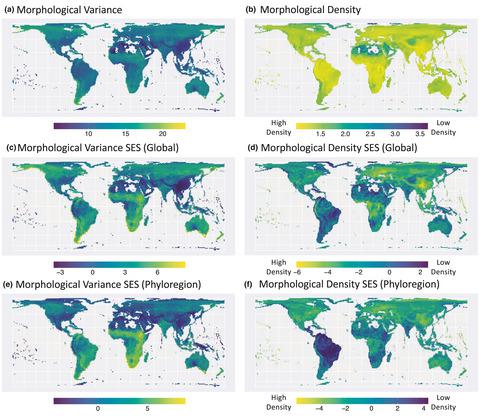当前位置:
X-MOL 学术
›
Ecol. Lett.
›
论文详情
Our official English website, www.x-mol.net, welcomes your
feedback! (Note: you will need to create a separate account there.)
Global biogeographic patterns of avian morphological diversity
Ecology Letters ( IF 7.6 ) Pub Date : 2022-02-24 , DOI: 10.1111/ele.13905 Emma C Hughes 1 , David P Edwards 1 , Jen A Bright 2 , Elliot J R Capp 1 , Christopher R Cooney 1 , Zoë K Varley 3 , Gavin H Thomas 1, 3
Ecology Letters ( IF 7.6 ) Pub Date : 2022-02-24 , DOI: 10.1111/ele.13905 Emma C Hughes 1 , David P Edwards 1 , Jen A Bright 2 , Elliot J R Capp 1 , Christopher R Cooney 1 , Zoë K Varley 3 , Gavin H Thomas 1, 3
Affiliation

|
Understanding the biogeographical patterns, and evolutionary and environmental drivers, underpinning morphological diversity are key for determining its origins and conservation. Using a comprehensive set of continuous morphological traits extracted from museum collections of 8353 bird species, including geometric morphometric beak shape data, we find that avian morphological diversity is unevenly distributed globally, even after controlling for species richness, with exceptionally dense packing of species in hyper-diverse tropical hotspots. At the regional level, these areas also have high morphological variance, with species exhibiting high phenotypic diversity. Evolutionary history likely plays a key role in shaping these patterns, with evolutionarily old species contributing to niche expansion, and young species contributing to niche packing. Taken together, these results imply that the tropics are both ‘cradles’ and ‘museums’ of phenotypic diversity.
中文翻译:

鸟类形态多样性的全球生物地理格局
了解生物地理模式、进化和环境驱动因素、支撑形态多样性是确定其起源和保护的关键。使用从博物馆收藏的 8353 种鸟类中提取的一套全面的连续形态特征,包括几何形态学喙形状数据,我们发现鸟类形态多样性在全球分布不均,即使在控制了物种丰富度之后,在超-多样化的热带热点。在区域层面,这些地区的形态差异也很大,物种表现出很高的表型多样性。进化史可能在塑造这些模式中发挥关键作用,进化上的老物种有助于生态位扩张,而年轻物种有助于生态位堆积。
更新日期:2022-02-24
中文翻译:

鸟类形态多样性的全球生物地理格局
了解生物地理模式、进化和环境驱动因素、支撑形态多样性是确定其起源和保护的关键。使用从博物馆收藏的 8353 种鸟类中提取的一套全面的连续形态特征,包括几何形态学喙形状数据,我们发现鸟类形态多样性在全球分布不均,即使在控制了物种丰富度之后,在超-多样化的热带热点。在区域层面,这些地区的形态差异也很大,物种表现出很高的表型多样性。进化史可能在塑造这些模式中发挥关键作用,进化上的老物种有助于生态位扩张,而年轻物种有助于生态位堆积。









































 京公网安备 11010802027423号
京公网安备 11010802027423号